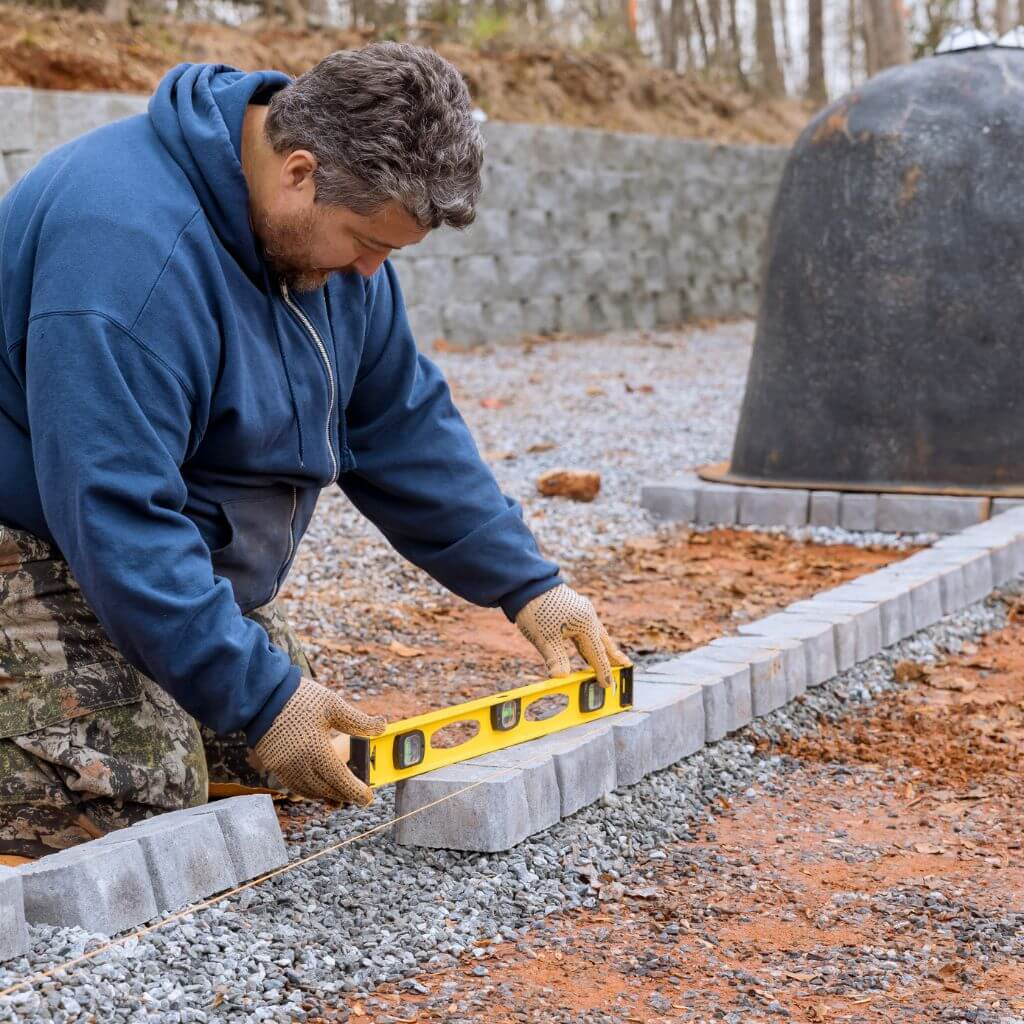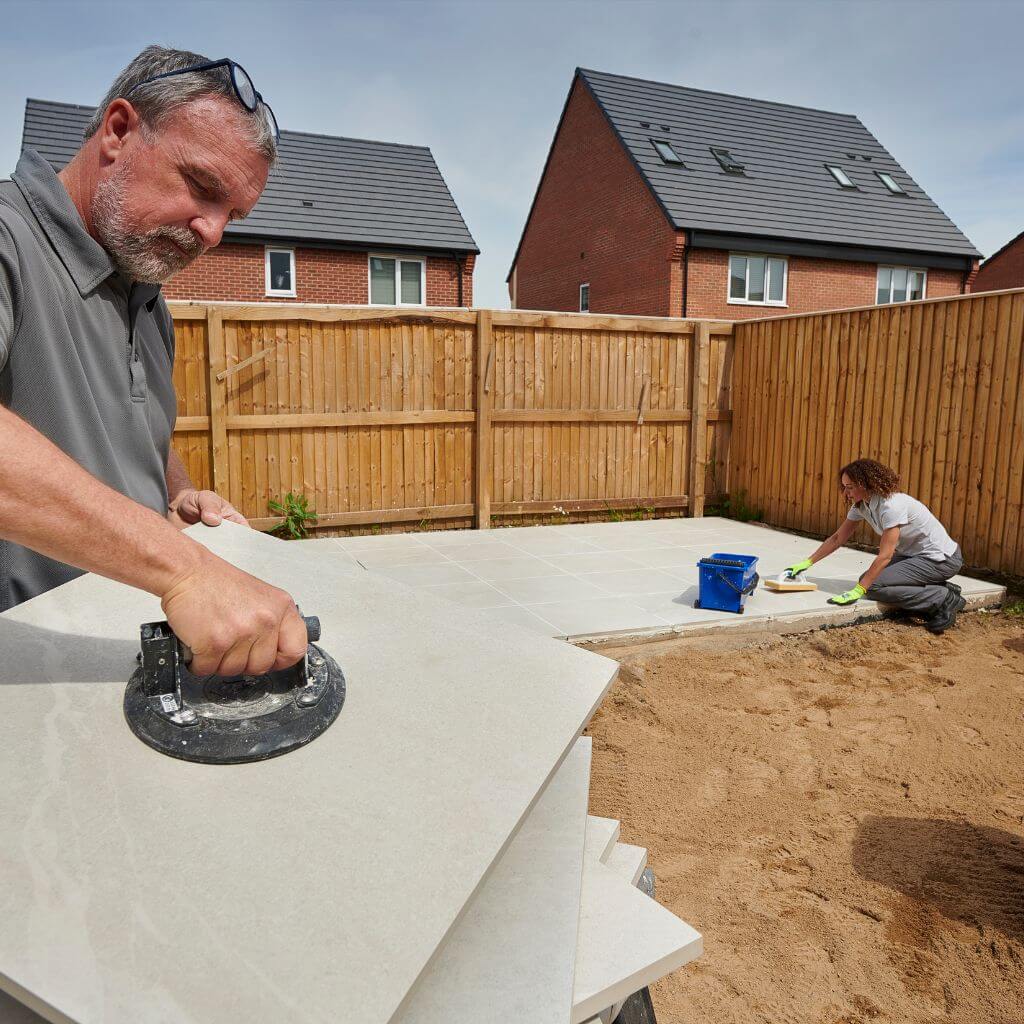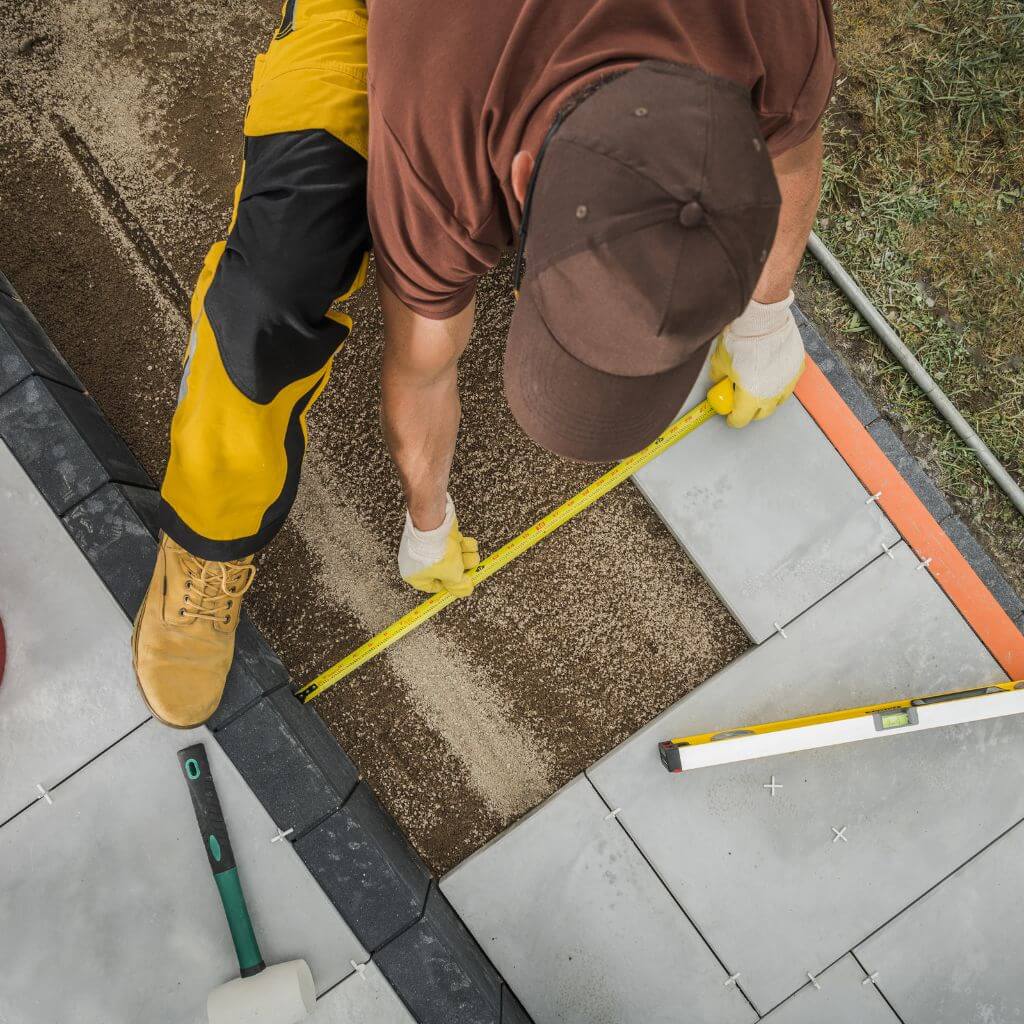
Are you a beginner looking to tackle the task of laying a patio but don’t know where to start? Well, look no further! In this comprehensive guide, we will walk you through the step-by-step process of laying a patio, from planning and preparation to the final finishing touches. Whether you’re hoping to create a cozy outdoor space for entertaining or simply looking to enhance the beauty of your yard, this article will provide you with all the information you need to confidently take on this DIY project. So grab your tools and let’s get started on transforming your outdoor space into a stunning patio oasis!

Choosing the Right Location | Guide to Laying a Patio
Assessing the Available Space
When choosing a location for your patio, it’s important to assess the available space in your backyard. Consider the size and shape of your outdoor area and determine how much of it you want to dedicate to your patio. Take into account any existing landscaping or structures that may impact the size and shape of your patio.
Considering Sunlight and Shade
Another crucial factor to consider when choosing a location for your patio is sunlight and shade. Think about how the sun moves throughout the day and which areas of your backyard receive the most and least amount of sunlight. Depending on your preferences, you may want to position your patio in a spot that gets ample sunlight or one that provides more shade.
Checking Drainage
Proper drainage is essential for a successful patio installation. Be sure to check the drainage patterns in your backyard and avoid areas that tend to collect water. If your chosen location has drainage issues, consider implementing drainage solutions such as French drains or slope adjustments to prevent water build-up on your patio.
Taking Accessibility into Account
Consider the accessibility of your chosen location. Think about how you will access the patio from your house and make sure the path is easy to navigate. If you have any mobility limitations or plan to frequently entertain guests, it’s important to choose a location that allows for easy access and enhances the functionality of your patio.
Planning and Designing the Patio
Deciding on Patio Shape and Size
When planning your patio, one of the first decisions to make is the shape and size of the patio. Consider the purpose of your patio and the activities you intend to enjoy on it. If you plan to entertain large groups or have ample space for outdoor furniture, you may want to opt for a larger patio. Additionally, think about the shape that best suits your backyard aesthetics and meets your functional needs.
Sketching the Layout
To visualize your patio design, it’s helpful to sketch out a layout. Measure the dimensions of your chosen patio area and use graph paper or an online design tool to create a scaled drawing. This will allow you to experiment with different patio shapes and arrangements and ensure that your final layout matches your vision.
Determining the Patio Material
Choosing the right patio material is crucial for the longevity and visual appeal of your outdoor space. There is a wide range of materials available, including concrete, natural stone, brick, and pavers. Consider factors such as durability, maintenance requirements, and aesthetic appeal when deciding on the material that best suits your needs and preferences.
Exploring Different Patio Styles
Patio styles vary greatly, ranging from modern and minimalist to traditional and rustic. Take some time to explore different patio styles and gather inspiration from online resources, home improvement magazines, or even your neighbors’ patios. Find a style that complements your home’s architecture and matches your personal tastes.
Understanding Local Building Regulations
Before proceeding with your patio project, it’s important to familiarize yourself with local building regulations. Different areas may have specific guidelines and restrictions regarding patio construction. Check with your local municipality or building department to ensure that you’re complying with all necessary regulations and obtaining any required permits.
Gathering the Necessary Tools and Materials
Essential Tools
To lay a patio successfully, you’ll need several essential tools. Some of the tools you may need include a tape measure, spirit level, rubber mallet, shovel, wheelbarrow, and a set of safety goggles and gloves. Having these tools on hand will make the construction process more efficient and safe.
Patio Materials
In addition to the necessary tools, you’ll also need the appropriate patio materials. This will depend on the material you’ve chosen for your patio surface. For example, if you opt for concrete, you’ll need cement, sand, aggregate, and a mixing container. If you’re using natural stone or pavers, you’ll require specific materials for the sub-base and jointing, such as crushed rock or sand.
Safety Equipment
Safety should be a top priority when laying a patio. Make sure to have safety equipment such as gloves and goggles to protect yourself from potential injuries, especially when handling tools or working with materials. Wearing the appropriate safety gear will help minimize risks and ensure a safer construction process.
Preparing the Site
Marking the Patio Area
Once you’ve chosen the location and determined the size of your patio, mark the area by using stakes and string to outline its boundaries. This step will give you a clear visual reference of the patio’s dimensions and help guide the excavation process.
Removing Vegetation
Before you can start the excavation process, it’s crucial to remove any existing vegetation within the marked patio area. Trim back any grass, plants, or weeds, and use a garden spade or shovel to remove them from the site. Ensuring a clean and clear area will simplify the subsequent steps of the patio installation process.
Excavating the Ground
Excavating the ground is a crucial step in preparing the site for your patio. Use a shovel or a mini-excavator to dig out the soil within the marked area, following the depth guidelines provided by your chosen patio material. Remove any excess soil and create a level surface for the patio base.
Compact the Soil
After excavating the ground, it’s important to compact the soil to ensure a stable base for your patio. Use a plate compactor or a hand tamper to firmly compact the soil, eliminating any remaining air pockets. This step will help prevent settling or shifting of the patio surface over time.
Installing Edging
To provide a defined edge for your patio and prevent the pavers or stones from shifting, it’s recommended to install edging. This can be done using materials such as plastic or metal garden edging, which should be securely anchored into the ground along the perimeter of the patio. Edging will help maintain the structural integrity of your patio and create a clean, polished look.

Creating a Solid Base
Adding a Geotextile Membrane
A geotextile membrane is a breathable fabric that is often recommended as a base layer for your patio. This material helps to prevent weed growth and provides additional stability and separation between the native soil and the sub-base material. Lay the geotextile membrane over the compacted soil, ensuring it covers the entire patio area.
Laying and Compacting Sub-Base Material
The sub-base material is an essential component of a solid patio base. This layer typically consists of crushed stone or gravel, which should be spread evenly over the geotextile membrane. Use a rake or shovel to distribute the material and a plate compactor to compact it thoroughly. Ensure that the sub-base has a consistent thickness and a level surface.
Checking for Evenness
To ensure a level and even patio surface, use a long straightedge or a screed board to check the surface’s evenness. This step is crucial for avoiding any potential unevenness or gaps in the patio surface. Adjust the sub-base material as needed, adding or removing it to achieve a uniformly level surface throughout the patio area.
Laying the Patio Surface
Mixing Mortar or Preparing Jointing Compound
Depending on the material you’ve chosen for your patio surface, you’ll either need to mix mortar or prepare a jointing compound. Mortar is typically used for materials like brick or natural stone, while jointing compound is suitable for pavers. Follow the manufacturer’s instructions to prepare the mortar or jointing compound to the desired consistency.
Placing and Leveling Paving Slabs
Carefully place the paving slabs or stones onto the prepared patio base, taking care to align them evenly and maintain consistent gaps. Use a spirit level to ensure each slab is level both in terms of its individual surface and in relation to the surrounding slabs. Make any necessary adjustments by tapping lightly with a rubber mallet.
Cutting Slabs to Fit
In some cases, it’s necessary to cut paving slabs to fit into specific areas or accommodate irregular edges. Use a diamond-bladed saw or a chisel and hammer to carefully cut the slabs according to your desired dimensions. Take accurate measurements and ensure a precise fit to maintain a polished appearance for your patio.
Filling in Gaps with Mortar or Jointing Compound
Once all the paving slabs have been laid and leveled, fill in the gaps between them with either mortar or jointing compound. Carefully apply the material, ensuring it fills the gaps completely and creates a uniform appearance. Use a pointing trowel or a grout float to smooth and level the mortar or compound, removing any excess material.
Allowing for Proper Curing
After completing the patio surface, allow sufficient time for the mortar or jointing compound to cure. This process ensures the material sets properly and provides the necessary strength and durability for your patio. Follow the manufacturer’s recommendations for curing time, which typically ranges from a few hours to a day or more.
Finishing Touches and Maintenance
Adding Decorative Elements
To enhance the visual appeal of your patio, consider adding decorative elements such as outdoor rugs, cushions, or artwork. These additions can add personality and make your patio feel more inviting and comfortable. Choose decor that suits your style and preferences, and ensure it can withstand outdoor conditions.
Applying Sealer (if necessary)
Depending on the material used for your patio surface, applying a sealer may be necessary to protect the surface from staining, weathering, and fading. Consult the manufacturer’s recommendations to determine whether a sealer is required for your specific patio material. If so, apply the sealer according to the instructions, ensuring full coverage.
Installing Drainage if Required
If your patio is in an area prone to water accumulation, it may be necessary to install a drainage system to prevent pooling or flooding. This can be done by incorporating French drains or installing a slope that allows water to flow away from the patio. Proper drainage will help maintain the integrity and longevity of your patio.
Regular Maintenance Tips
To keep your patio in top condition, regular maintenance is essential. This includes sweeping or hosing off debris, cleaning stains promptly, and inspecting for any cracks or damages that may require repairs. Additionally, make sure to follow any specific maintenance guidelines provided by the manufacturer of your chosen patio material.
Enhancing Patio Functionality
Incorporating Lighting
To extend the usability of your patio into the evening hours, consider incorporating lighting features. Options include string lights, lanterns, or even built-in lighting fixtures. Strategically placed lighting can create a warm and inviting atmosphere, making your patio a cozy place to socialize or relax.
Choosing Outdoor Furniture
Selecting the right outdoor furniture is key to enhancing both the comfort and functionality of your patio. Consider your intended use for the space, whether it’s dining, lounging, or both, and choose furniture that suits your needs. Look for durable, weather-resistant materials that can withstand outdoor conditions and provide long-lasting comfort.
Installing a Firepit or Barbecue Area
For those who enjoy outdoor cooking and entertaining, installing a firepit or barbecue area can be a fantastic addition to your patio. These features not only provide a focal point but also create opportunities for gathering and enjoying meals with family and friends. Ensure proper safety measures are in place when incorporating fire features.
Adding Planters and Greenery
Integrating planters and greenery into your patio design can bring life and color to the space. Consider using a variety of plants, flowers, and even small trees to create a lush and inviting atmosphere. Choose plants that are suitable for the local climate and your desired level of maintenance. Additionally, be mindful of plant placement to ensure they don’t obstruct the patio’s functionality.
Seeking Professional Help
Knowing When to Hire a Professional
While laying a patio is achievable for many DIY enthusiasts, some circumstances may warrant hiring a professional. If your patio design is complex, you have limited construction experience, or you lack the necessary tools and equipment, seeking professional help is advisable. Professional contractors can ensure a high-quality, safe, and long-lasting patio installation.
Finding and Selecting a Reputable Patio Contractor
When hiring a patio contractor, it’s important to do thorough research to find a reputable and experienced professional. Seek recommendations from friends, family, or neighbors who have had patio installations done. Look for contractors with positive reviews, proper licenses, and insurance coverage. Request quotes and compare them to make an informed decision.
Obtaining Quotes and Estimates
Before hiring a patio contractor, obtain quotes and estimates from multiple professionals. This will allow you to compare prices, evaluate the scope of work included, and make an informed decision. Ensure that the quotes provide a detailed breakdown of costs and any additional services or materials required for the patio installation.
Enjoying Your New Patio
Setting Up Outdoor Activities
Now that your patio is complete, it’s time to enjoy all the outdoor activities it can facilitate. Whether it’s hosting barbecues, alfresco dining, or simply relaxing with a book, your new patio is a versatile space that can be tailored to your preferences and needs. Set up furniture, arrange seating areas, and create a welcoming ambiance to make lasting memories with family and friends.
Maintaining the Patio’s Beauty
Regular maintenance is key to preserving the beauty and functionality of your patio. Keep the surface clean by sweeping away debris and removing stains promptly. If necessary, reapply sealant periodically to protect the surface from weathering. Regularly inspect the patio for any damages or wear and address them promptly to avoid further deterioration.
Making Memories with Family and Friends
Ultimately, the purpose of your new patio is to create a space where you can make cherished memories with your loved ones. From intimate conversations to laughter-filled gatherings, your patio is a backdrop for countless moments of joy and connection. Embrace the opportunities it offers and enjoy the countless hours of outdoor relaxation and entertainment it provides.
